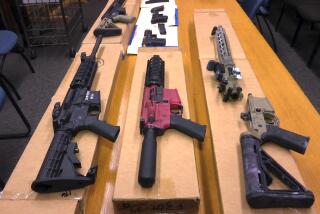Justices OK City Role in Fighting Graffiti : Judiciary: State high court rules that a California law does not preempt more restrictive local ordinances. Case concerned a Los Angeles ban on open display of aerosol cans.
- Share via
SAN FRANCISCO — The state Supreme Court on Thursday gave cities more power to combat graffiti, upholding a Los Angeles ordinance requiring stores to keep aerosol spray paint cans and wide-tip pens in display cases so vandals cannot steal them.
The court held 6 to 1 that the Legislature, in enacting a state law aimed at curbing graffiti, did not intend to preempt a municipal ordinance that provides additional restrictions.
The widely awaited ruling opens the way for municipalities throughout the state to enact tough anti-graffiti ordinances or to apply existing laws that had not been enforced pending high court action on the issue. A coalition of 62 California cities had urged the justices to uphold the ordinance.
The decision came as the problem of graffiti has intensified in urban areas, with the city of Los Angeles alone spending $4 million annually to clean up the blight.
“This ruling is a major victory in the war on graffiti,” said Los Angeles Deputy City Atty. Henry G. Morris.
“There is a very high incidence of theft of these items, and those who steal them are the main individuals who use them to inscribe graffiti,” Morris said. “This ordinance is a good device for stopping the problem at its source.”
Michael Hickok of Los Angeles, an attorney for paint companies that opposed the ordinance, said the ruling would prove costly for manufacturers and retailers.
Some vendors may abandon the products when faced with buying closed display cases, he said, and sales will go down as restricted materials are removed from open shelves and become less accessible to customers.
Hickok voiced doubt about the connection between shoplifting spray paint and graffiti, saying that minors caught inscribing graffiti are likely to falsely claim they stole the products, rather than admit to an illegal purchase or to implicate a friendly store owner.
There are more effective means of curbing the blight, he added, such as increasing penalties for graffiti or forcing parents to pay cleanup costs.
The case arose after the Los Angeles City Council approved an ordinance in 1990 requiring that aerosol cans and marker pens commonly used by graffiti vandals be stored “in an area viewable by, but not accessible to, the public.”
The aim was to curb theft by minors by forcing customers to summon a clerk to obtain the products from a display case. State law makes it a misdemeanor to sell aerosol paint to minors, prohibits minors from buying aerosol paint and requires retailers to post a warning that graffiti vandalism is punishable by fine or jail.
Ordinance sponsors said that graffiti was growing worse by the day. City departments were spending $3 million a year on graffiti removal and allocating another $1 million to outside contractors to help with the cleanup.
After the ordinance was passed, lawyers for Sherwin-Williams Co. and Plasti-Kote Inc., which together account for 60% of the aerosol paint sold in the city, filed suit in Los Angeles Superior Court. The firms contended the local measure was preempted by state anti-graffiti statutes restricting the sale and use of aerosol paints.
A Superior Court judge agreed that the ordinance was preempted and issued an injunction barring its enforcement. A state Court of Appeal upheld the ruling last April.
But the state high court ruling Thursday, in an opinion by Justice Stanley Mosk, held that the state law was no barrier.
Mosk acknowledged that in passing an aerosol-paint law in 1981, the Legislature had stated its intention to preempt local controls on the product. But new legislation in 1988 contained no such provision, indicating the way was clear for Los Angeles and other municipalities to enact ordinances, the justice said.
More to Read
Sign up for Essential California
The most important California stories and recommendations in your inbox every morning.
You may occasionally receive promotional content from the Los Angeles Times.













